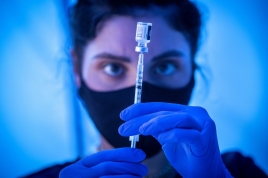52% of California adults at least partially vaccinated
Friday, April 16, 2021
More than half of California adults have now received at least one COVID-19 vaccine dose, a promising milestone that comes as the state is now inoculating as wide a swath of its residents as possible.
To date, 52.2% of Californians 18 and older have been at least partially vaccinated, according to the latest data from the Centers for Disease Control and Prevention.
That level of coverage ranks 11th among all states, federal figures show, and is higher than the proportion of adults who have received a dose in other heavily populated states — including Pennsylvania, 51.8%; New York, 51.3%; Texas, 45%; and Florida, 44.8%.
Nationwide, 48.3% of adult Americans have received at least one shot.
Reaching 50% “is good, but it’s not good enough,” Gov. Gavin Newsom said Thursday.
“We are making progress. We’re going to defeat this disease. We’re going to end this pandemic,” he said during a news conference. “There’s a bright light at the end of the tunnel, but we still have more work to do.”
A major item on the state’s to-do list is ensuring that those who have been partially vaccinated for COVID-19 complete their inoculation regimen.
The two vaccines being most widely administered both nationwide and in California, from Pfizer-BioNTech and Moderna, each require two doses, given weeks apart.
As a result, while more than half of California adults have received at least one dose, only 29.2% are fully vaccinated.
That percentage trails the nationwide figure, 30.3%, and ranks 36th among states.
The two vaccines being most widely administered both nationwide and in California, from Pfizer-BioNTech and Moderna, each require two doses, given weeks apart.
As a result, while more than half of California adults have received at least one dose, only 29.2% are fully vaccinated.
That percentage trails the nationwide figure, 30.3%, and ranks 36th among states.
And, as the data demonstrate, having a readily available and usable supply of the one-shot Johnson & Johnson vaccine would undoubtedly accelerate the state’s vaccination effort.
Newsom, though, said California expects increasing supplies of Pfizer and Moderna will help cover the difference.
He also noted that the state’s direct federal allocation, expected to be about 1.9 million total doses next week, is not the only source of vaccine. Up to 1.5 million more doses are expected to be delivered to other vaccination sites supported directly by the federal government, such as qualified health clinics and pharmacies.
“The challenge is manufactured supply, and so the issue will resolve itself as more Moderna and more Pfizer make their way into the state and throughout the United States,” Newsom said. “But that’s foundationally been the constraint and been the challenge in the state of California.”
That’s particularly the case now as all Californians 16 and over became eligible to be vaccinated as of Thursday.
Widespread vaccination represents the surest, and quickest, way out of the COVID-19 pandemic, officials and experts say.
But with new cases on the rise nationwide, federal health officials remain concerned about the trajectory of the pandemic.
As of Wednesday, the country’s seven-day average of daily new coronavirus cases was 69,577 — up 31% from a month ago, federal figures show.
“The increasing trends in cases, hospitalizations and deaths are very concerning, and they threaten the progress we’ve already made,” CDC Director Dr. Rochelle Walensky said during a briefing Friday.
One factor fueling the recent rise, she said, is “relaxed prevention efforts in states across the country, such as relaxed mask mandates or loosened restrictions on indoor restaurant seating.”
“Another reason for these increases is the continued spread of highly transmissible variants ... which makes the race to stop the transmission even more challenging, and threatens to overwhelm our healthcare system again in parts of this country,” she said.
California has also recently seen an increase in reported new coronavirus cases.
Over the last week, the state has reported an average of 3,069 cases per day, a 21.1% increase from two weeks ago, according to data compiled by The Times.
In spite of that, CDC data show that California’s latest seven-day new case rate — 52.7 per 100,000 people per day — is the fourth-lowest among all states and significantly below the nationwide rate of 146.7.
By comparison, the highest rates have been recorded in Michigan, with 551.6 per 100,000 people; Rhode Island, 304.5; New Jersey, 287.2; Pennsylvania, 261.6; and Minnesota, 256.1.
Among larger states, the comparable rates over the same time period were 204.9 in Florida and 73.3 in Texas.
While any increase in cases is worth monitoring, California’s other coronavirus metrics continue to show promising signs of progress.
Though it’s oscillated a bit recently, the number of coronavirus-positive Californians hospitalized — 1,833 on Thursday — has fallen to a level not seen since last spring.
Still, officials say residents need to continue taking steps to keep themselves, their families and their neighbors safe until more people can be vaccinated.
As Newsom emphasized, “This disease is not taking the month off or the summer off. This disease has not gone away.”
“Let’s not let down our guard. Let’s not take these masks off,” he said. “We still have work to do. The biggest mistake in this country that’s being perpetuated are people that are just giving up, not requiring these face coverings and just assuming that the mission somehow is accomplished. It’s not. This disease will come roaring back.”
https://www.latimes.com/california/story/2021-04-16/52-of-california-adults-at-least-partially-vaccinated





